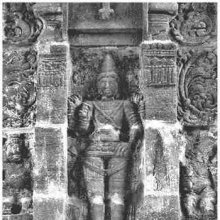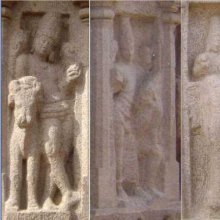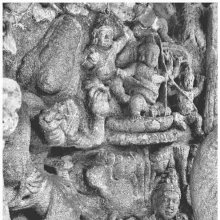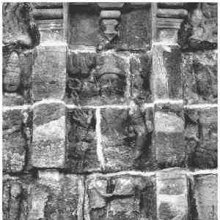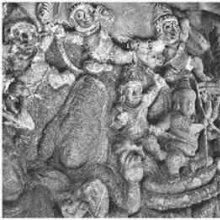Skandha, Skamdha, Skamda: 30 definitions
Introduction:
Skandha means something in Buddhism, Pali, Hinduism, Sanskrit, Jainism, Prakrit, the history of ancient India, Marathi. If you want to know the exact meaning, history, etymology or English translation of this term then check out the descriptions on this page. Add your comment or reference to a book if you want to contribute to this summary article.
Images (photo gallery)
(+13 more images available)
In Hinduism
Purana and Itihasa (epic history)
Source: archive.org: Puranic EncyclopediaSkandha (स्कन्ध).—A nāga (serpent) born in the family of Dhṛtarāṣṭra. This serpent was burnt to death in the sacrificial fire of the serpent sacrifice of Janamejaya. (Mahābhārata Ādi Parva, Chapter 57, Verse 18).

The Purana (पुराण, purāṇas) refers to Sanskrit literature preserving ancient India’s vast cultural history, including historical legends, religious ceremonies, various arts and sciences. The eighteen mahapuranas total over 400,000 shlokas (metrical couplets) and date to at least several centuries BCE.
Ayurveda (science of life)
Agriculture (Krishi) and Vrikshayurveda (study of Plant life)
Source: Shodhganga: Drumavichitrikarnam—Plant mutagenesis in ancient IndiaSkandha (स्कन्ध) refers to the “stem (of a tender plant)”, according to the Vṛkṣāyurveda by Sūrapāla (1000 CE): an encyclopedic work dealing with the study of trees and the principles of ancient Indian agriculture.—Accordingly, “A plant which is not too tender should be cut at its stem (taru-skandha) and then slightly burnt. Thereafter it should be smeared with the mixture of clarified butter, cow dung, rock salt, honey and flesh. A nail should then be driven in the root in a slanting manner. The plant then should be watered beautiful branches and without fail produces fruits even in a dwarf state”.
Unclassified Ayurveda definitions
Source: gurumukhi.ru: Ayurveda glossary of termsSkandha (स्कन्ध):—[skandhaḥ] Shoulder

Āyurveda (आयुर्वेद, ayurveda) is a branch of Indian science dealing with medicine, herbalism, taxology, anatomy, surgery, alchemy and related topics. Traditional practice of Āyurveda in ancient India dates back to at least the first millenium BC. Literature is commonly written in Sanskrit using various poetic metres.
Vastushastra (architecture)
Source: OpenEdition books: Architectural terms contained in Ajitāgama and RauravāgamaSkandha (स्कन्ध) refers to “molding (hollow) of the crown motif and the capital §§ 2.8, 20, 31.”.—(For paragraphs cf. Les enseignements architecturaux de l'Ajitāgama et du Rauravāgama by Bruno Dagens)

Vastushastra (वास्तुशास्त्र, vāstuśāstra) refers to the ancient Indian science (shastra) of architecture (vastu), dealing with topics such architecture, sculpture, town-building, fort building and various other constructions. Vastu also deals with the philosophy of the architectural relation with the cosmic universe.
Shaktism (Shakta philosophy)
Source: Google Books: ManthanabhairavatantramSkandha (स्कन्ध) refers to the “shoulders”, according to the Manthānabhairavatantra, a vast sprawling work that belongs to a corpus of Tantric texts concerned with the worship of the goddess Kubjikā.—Accordingly, while describing the signs of one who is a Siddha: “There is (an auspicious) line on his foot and (the lines) on his hand (are shaped) like an auspicious lotus. His shoulders are equal [i.e., sama-skandha] as are (his) teeth; his neck and breasts are upraised. Or else he may be bent over. Such a one is part of the Siddha lineage. (His) thigh is (strong as if) issuing from a wheel and he has a faint auspicious line of hair (on his belly). His gait is playful and his body well proportioned. Such is the mark of a Siddha”.

Shakta (शाक्त, śākta) or Shaktism (śāktism) represents a tradition of Hinduism where the Goddess (Devi) is revered and worshipped. Shakta literature includes a range of scriptures, including various Agamas and Tantras, although its roots may be traced back to the Vedas.
Yoga (school of philosophy)
Source: ORA: Amanaska (king of all yogas): A Critical Edition and Annotated Translation by Jason BirchSkandha (स्कन्ध) refers to the “shoulders”, according to the Mataṅgapārameśvaratantra (Mataṅgapārameśvara’s Yogapāda) verse 2.23-27.—Accordingly, while discussing ancillary and seated poses in Yoga: “[...] Having raised and broadened the chest and having made the arms loose, the wise [Yogin] should extend his back and raise the region of the shoulders (skandha-deśa). He should diligently hold the neck still, very steady and straight [but] not too rigid nor bent [to one side]. [...]”.

Yoga is originally considered a branch of Hindu philosophy (astika), but both ancient and modern Yoga combine the physical, mental and spiritual. Yoga teaches various physical techniques also known as āsanas (postures), used for various purposes (eg., meditation, contemplation, relaxation).
In Buddhism
Tibetan Buddhism (Vajrayana or tantric Buddhism)
Source: archive.org: The Indian Buddhist IconographySkandha (स्कन्ध) refers to the “five cosmic elements”, according to Vajrayāna or Tantric Buddhism.—The Buddhists believe that the world is composed of five cosmic elements or Skandhas. The five Skandhas are Rūpa (form), Vedanā (sensation), Saṃjñā (name), Saṃskāra (conformation) and Vijñāna (consciousness). These elements are eternal cosmic forces and are without a beginning or an end. These cosmic forces are deified in Vajrayāna as the five Dhyāni Buddhas. In the course of time they were regarded as the five primordial gods responsible for this diversified creation, [..].

Tibetan Buddhism includes schools such as Nyingma, Kadampa, Kagyu and Gelug. Their primary canon of literature is divided in two broad categories: The Kangyur, which consists of Buddha’s words, and the Tengyur, which includes commentaries from various sources. Esotericism and tantra techniques (vajrayāna) are collected indepently.
Mahayana (major branch of Buddhism)
Source: Wisdom Library: Maha Prajnaparamita SastraSkandha (स्कन्ध) refers to the “shoulders”, according to Mahāprajñāpāramitāśāstra (chapter 19).—Accordingly, “Furthermore, some say that generosity is the cause and condition (hetupratyaya) for obtaining the thirty-two marks. Why is that? [...] One finds out what the supplicant wants and gives it to him. For this act, one obtains the marks consisting of having a chest like a lion (siṃhapūrvārdha-kāya) and perfectly rounded shoulders (susaṃvṛtta-skandha). [...]”.
Source: academia.edu: A Study and Translation of the GaganagañjaparipṛcchāSkandha (स्कन्ध) refers to the “(five) aggregates”, according to the Gaganagañjaparipṛcchā: the eighth chapter of the Mahāsaṃnipāta (a collection of Mahāyāna Buddhist Sūtras).—Accordingly, “Then, the Lord went on to speak these verses: ‘[...] (82) The dharma is taught in order to purify the five kinds of sight (pañca-cakṣus), to illuminate the five kinds of abilities (pañca-indriya), to eliminate the five states of existence (pañca-gati), and to makes the five aggregates disappear (pañca-skandha). It is not dependent on this side nor that side, but established in the realm of the dharma, same as the sameness of the sky, and it exalts a being in accordance with the knowledge of the Buddha. [...]’”.

Mahayana (महायान, mahāyāna) is a major branch of Buddhism focusing on the path of a Bodhisattva (spiritual aspirants/ enlightened beings). Extant literature is vast and primarely composed in the Sanskrit language. There are many sūtras of which some of the earliest are the various Prajñāpāramitā sūtras.
General definition (in Buddhism)
Source: Wisdom Library: Dharma-samgrahaSkandha (स्कन्ध) or Skandhamāra refers to the “components destroyer” and represents one of the “four destroyers” (māra) as defined in the Dharma-saṃgraha (section 80). The Dharma-samgraha (Dharmasangraha) is an extensive glossary of Buddhist technical terms in Sanskrit (e.g., skandha). The work is attributed to Nagarguna who lived around the 2nd century A.D.
Source: Shambala Publications: GeneralSkandha Skt. (Pali, khanda), lit., “group, aggregate, heap”; term for the five aggregates, which constitute the entirety of what is generally known as “personality.”
They are
- corporeality or form (rupa),
- sensation (vedanā),
- perception (Skt., samjñā; Pali, sannā),
- mental formations (samskāra),
- consciousness (vijñāna).
These aggregates are frequently referred to as “aggregates of attachment,” since (except in the case of arhats and buddhas) craving or desire attaches itself to them and attracts them to itself; thus it makes of them objects of attachment and brings about suffering.
The characteristics of the skandhas are birth, old age, death, duration, and change. They are regarded as without essence (anātman), impermanent (anitya), empty (shūnya), and suffering-ridden (duhkha).
In Jainism
Jain philosophy
Source: archive.org: Anekanta Jaya Pataka of Haribhadra SuriSkandha (स्कन्ध) refers to an “aggregate of paramāṇus”, as occurring in the Anekāntajayapatākā-prakaraṇa, a Śvetāmbara Jain philosophical work written by Haribhadra Sūri.—[Cf. Vol. II, P. 11, l. 20]
-
General definition (in Jainism)
Source: Wisdom Library: JainismSkandha (स्कन्ध, “trunk”).—One of the ten kinds of “plant-bodies” (vanaspati) a soul (jīva) can be reborn as due to karma. Skandha and other plant-bodies are within the animal world (tiryag-gati) which is one of the four divisions of saṃsāra where souls are reborn.
Source: Atma Dharma: Principles of JainismMolecule; The union or bondage (bandha) of two or more than two atom is called a molecule (skandha).
How many types of molecules (skandhas) are there?
The molecules are of 23 types; such as
- Ahar (Bodies-making)
- Vargana,
- Taijas (Luminous) Vargana,
- Bhasha (Speech) Vargana,
- Mano (Mind) Vargana,
- Karman (Karmic Matter) Vargana, etc.
Skandha (स्कन्ध) refers to an “aggregate” or “molecule” according to the 2nd-century Tattvārthasūtra 5.10.—What is the meaning of an aggregate (skandha)? The sub-atoms (paramāṇu) which get bonded each other are called an aggregate. How many space-points does an aggregate (skandha) have? Some aggregates are formed by two, three or four sub-atoms. Some are formed by numerable, innumerable or infinite sub-atoms. So the aggregate has different number of space point accordingly.
Skandha (“aggregate”) refers to one of the two types of matter (pudgala) according to the 2nd-century Tattvārthasūtra 5.5.—What is the meaning of aggregate /molecule (skandha)? An entity formed by combining two, three or more sub-atoms is called an aggregate. How many types of matter as aggregate are there? These are of six types namely gross-gross, gross, gross-subtle, subtle-gross, subtle and subtle-subtle.
According to Tattvārthasūtra 5.26, how is an aggregate (skandha) created? An aggregate is created by fusion, fission or fusion-fission. How many sub-atoms (paramāṇu) are needed to form an aggregate by fusion (saṃghāta)? Two or more sub-atoms are needed to form an aggregate. How does fusion (saṃghāta) and fission (bheda) together create an aggregate (skandha)? When one aggregate separates or is divided into sub aggregate and one of such divisions combine with another aggregate, then we get a new aggregate by fusion and fission.
Source: The University of Sydney: A study of the Twelve ReflectionsSkandha (स्कन्ध) refers to the “(immense) trunk” (of restraint), according to the 11th century Jñānārṇava, a treatise on Jain Yoga in roughly 2200 Sanskrit verses composed by Śubhacandra.—Accordingly, “Glory to the great tree that is stopping the influx of karma whose opponent is conquered, which is rooted in all the rules of conduct for a mendicant, whose great trunk is restraint [com.—saṃyama-utkaṭa-skandha—‘the one whose immense trunk is restraint’], whose full branches are tranquillity, which is covered with the blossom of virtue [and] is beautiful because of producing whole fruit through the reflections. [Thus ends the reflection on] stopping the influx of karma”.
Synonyms: Kāṇḍa, Skandhaka.

Jainism is an Indian religion of Dharma whose doctrine revolves around harmlessness (ahimsa) towards every living being. The two major branches (Digambara and Svetambara) of Jainism stimulate self-control (or, shramana, ‘self-reliance’) and spiritual development through a path of peace for the soul to progess to the ultimate goal.
India history and geography
Source: Cologne Digital Sanskrit Dictionaries: Indian Epigraphical GlossarySkandha.—(LP), an instalment; cf. skandaka. Note: skandha is defined in the “Indian epigraphical glossary” as it can be found on ancient inscriptions commonly written in Sanskrit, Prakrit or Dravidian languages.

The history of India traces the identification of countries, villages, towns and other regions of India, as well as mythology, zoology, royal dynasties, rulers, tribes, local festivities and traditions and regional languages. Ancient India enjoyed religious freedom and encourages the path of Dharma, a concept common to Buddhism, Hinduism, and Jainism.
Languages of India and abroad
Marathi-English dictionary
Source: DDSA: The Molesworth Marathi and English Dictionaryskandha (स्कंध).—m (S) The shoulder, the region from the neck to the shoulder-joint. 2 The corresponding region of quadrupeds. 3 An arm of a tree; a large bough or branch. 4 A section of a book, a book, a chapter. 5 A common term for the five branches of knowledge or objects of the understanding. See pañcaskandha. 6 A form of military array. 7 A common term for the five objects of sense,--form, taste, smell &c. See pañcaviṣaya & indriya. 8 A multitude or a quantity. 9 A sort of metre. 10 Any article essential to the coronation of a king; as a jar filled with holy water, a parasol, a chowrie &c. 11 A division of the winds. Seven are enumerated. See saptaskandha. 12 A branch (or department) of jyōtiṣa viewed as a tree. These are three; viz. gaṇitaskandha The science of number and measure, mathematics; hōrāskandha The science of astronomy and astrology; saṃhitāskandha The science of times and seasons, portents and presages--occult signs and foreshowings.
Source: DDSA: The Aryabhusan school dictionary, Marathi-Englishskandha (स्कंध).—m The shoulder. A large branch. A chapter.
Marathi is an Indo-European language having over 70 million native speakers people in (predominantly) Maharashtra India. Marathi, like many other Indo-Aryan languages, evolved from early forms of Prakrit, which itself is a subset of Sanskrit, one of the most ancient languages of the world.
Sanskrit dictionary
Source: DDSA: The practical Sanskrit-English dictionarySkandha (स्कन्ध).—[skandyate āruhyate'sau sukhena śākhayā vā karmaṇi ghañ pṛṣo°; cf. Uṇādi-sūtra 4.26]
1) The shoulder; महर्षभस्कन्ध- मनूनकन्धरम् (maharṣabhaskandha- manūnakandharam) Kirātārjunīya 14.4.
2) The body; सूक्ष्मयोनीनि भूतानि तर्कगम्यानि कानिचित् । पक्ष्मणोऽपि निपातेन येषां स्यात् स्कन्धपर्ययः (sūkṣmayonīni bhūtāni tarkagamyāni kānicit | pakṣmaṇo'pi nipātena yeṣāṃ syāt skandhaparyayaḥ) || Mahābhārata (Bombay) 12.15.26.
3) The trunk or stem of a tree; तीव्राघातप्रतिहततरुस्कन्धलग्नैकदन्तः (tīvrāghātapratihatataruskandhalagnaikadantaḥ) Ś.1.32; R.4.57; Meghadūta 55.
4) A branch or large bough; स्कन्धाधिरूढोज्ज्वलनीलकण्ठान् (skandhādhirūḍhojjvalanīlakaṇṭhān) Śiśupālavadha 4.7.
5) A department or branch of human knowledge; Śiśupālavadha 2.28.
6) A chapter, section, division (of a book).
7) A division or detachment of an army; द्वितीयं प्रेषयामास बलस्कन्धं युधिष्ठिरः (dvitīyaṃ preṣayāmāsa balaskandhaṃ yudhiṣṭhiraḥ) Mahābhārata (Bombay) 5.196. 9; R.4.3.
8) A troop, multitude, group; 'स्कन्धः स्यान्नृपतौ वंशे साम्परायसमूहयोः (skandhaḥ syānnṛpatau vaṃśe sāmparāyasamūhayoḥ)' इति मेदिनी (iti medinī); Mahābhārata (Bombay) 14.45.1.
9) The five objects of sense.
1) The five forms of mundane consciousness (in Buddhistic phil.); सर्वकार्यशरीरेषु मुक्त्वाङ्गस्कन्धपञ्चकम् (sarvakāryaśarīreṣu muktvāṅgaskandhapañcakam) Śiśupālavadha 2.28.
11) War, battle.
12) A king.
13) An agreement.
14) A road, way; Mahābhārata (Bombay) 3.
15) A wise or learned man.
16) A heron.
17) Articles used at the coronation of a king.
18) A part (aṃśa); तदवध्यानविस्रस्तपुण्यस्कन्धस्य भूरिदः (tadavadhyānavisrastapuṇyaskandhasya bhūridaḥ) Bhāgavata 11.23.1.
-ndhā 1 A branch.
2) A creeper.
Derivable forms: skandhaḥ (स्कन्धः).
Source: Cologne Digital Sanskrit Dictionaries: Shabda-Sagara Sanskrit-English DictionarySkandha (स्कन्ध).—m.
(-ndhaḥ) 1. The shoulder, the head of the humerus. 2. The body. 3. The trunk of a tree. 4. A king, a prince. 5. A sort of metre. 6. A multitude, a quantity. 7. War, battle. 8. Any article essential to the coronation of a king, as a jar filled with holy water, a parasol, a Chowri, &c. 9. Part of an army or a form of array. 10. Any one of five branches of human or mundane knowledge, or objects of understanding. 11. A road, a way. 12. A heron. 13. An engagement, an agreement. 14. A wise old man. 15. A learned man, a teacher. 16. Match or equality in the humps of a pair of draft oxen. 17. The five objects of sense, or form, taste, smell, &c. 18. A book, a section, a chapter. f.
(-ndhā) 1. A branch. 2. A creeper. E. ka the head, and dhā to hold, aff. ka, and suṭ initial augment.
Source: Cologne Digital Sanskrit Dictionaries: Benfey Sanskrit-English DictionarySkandha (स्कन्ध).—I. m. 1. The shoulder, [Pañcatantra] 144, 23. 2. The body, [Mālatīmādhava, (ed. Calc.)] 84, 17. 3. The trunk of a tree, [Pañcatantra] iii. [distich] 149. 4. A branch, [Pañcatantra] 134, 5. 5. A branch of human knowledge. 6. A book, [Bhāgavata-Purāṇa, (ed. Burnouf.)] i. ii., etc. 7. The five objects of sense. 8. The five forms of mundane consciousness, in the Bauddha philosophy, [Śiśupālavadha] 2, 26; cf. Burnouf, Introd. à l'Hist. du Buddh. 475. 9. A road. 10. Part of an army. 11. War. 12. A multitude. 13. An agreement. 14. A king. 15. A wise or learned man. 16. A heron. Ii. f. dhā. 1. A branch. 2. A creeper.
Source: Cologne Digital Sanskrit Dictionaries: Cappeller Sanskrit-English DictionarySkandha (स्कन्ध).—[masculine] shoulder, stem or trunk of a tree; section, chapter of a book, mass, multitude, a whole or aggregate.
Source: Cologne Digital Sanskrit Dictionaries: Aufrecht Catalogus CatalogorumSkandha (स्कन्ध) as mentioned in Aufrecht’s Catalogus Catalogorum:—poet. Mentioned by Rājaśekhara Śp. p. 77.
Source: Cologne Digital Sanskrit Dictionaries: Monier-Williams Sanskrit-English Dictionary1) Skandha (स्कन्ध):—m. ([according to] to [Uṇādi-sūtra iv, 206], from √skand in the sense of ‘rising’ ?) the shoulder, upper part of the back or region from the neck to the shoulder-joint (in men and animals), [Atharva-veda] etc. etc.
2) the stem or trunk of a tree ([especially] that part of the stem where the branches begin), [Śāṅkhāyana-gṛhya-sūtra; Mahābhārata] etc.
3) a large branch or bough, [cf. Lexicographers, esp. such as amarasiṃha, halāyudha, hemacandra, etc.]
4) a troop, multitude, quantity, aggregate (cf. kari-, nara-sk), [Mahābhārata; Bhāgavata-purāṇa]
5) a part, division ([especially] a division of an army or a form of military array), [Mahābhārata; Kāvya literature] etc.
6) a chapter, section (of a book, system etc.), [Varāha-mihira’s Bṛhat-saṃhitā; Caraka]
7) a tract, path, region ([especially] of the winds, said to be seven), [Mahābhārata; Harivaṃśa]
8) (in [philosophy]) the five objects of sense (See viṣaya), [Horace H. Wilson]
9) (with Buddhists) the five constituent elements of being (viz. rūpa, ‘bodily form’; vedanā, ‘sensation’; saṃjñā, ‘perception’; saṃskāra, ‘aggregate of formations’; vijñāna, ‘consciousness or thought-faculty’), [Monier-Williams’ Buddhism 109]
10) (with Jainas) the body (in the widest sense = piṇḍa), [Sarvadarśana-saṃgraha]
11) a [particular] form of the Āryā metre, [Colebrooke]
12) a king, prince, [cf. Lexicographers, esp. such as amarasiṃha, halāyudha, hemacandra, etc.]
13) any article used at the coronation of a king (as a jar filled with consecrated water, an umbrella etc.), [Horace H. Wilson]
14) a sage, teacher, [ib.]
15) war, battle, [ib.]
16) an engagement, agreement, [ib.]
17) a heron, [ib.]
18) equality of height in the humps of a pair of draught oxen, [ib.]
19) = samparāya and bhadrādi, [cf. Lexicographers, esp. such as amarasiṃha, halāyudha, hemacandra, etc.]
20) Name of a serpent-demon, [Mahābhārata]
21) of a poet, [Catalogue(s)]
22) often [wrong reading] for skanda
23) Skandhā (स्कन्धा):—[from skandha] f. a branch, [cf. Lexicographers, esp. such as amarasiṃha, halāyudha, hemacandra, etc.]
24) [v.s. ...] a creeper, [cf. Lexicographers, esp. such as amarasiṃha, halāyudha, hemacandra, etc.]
Source: Cologne Digital Sanskrit Dictionaries: Yates Sanskrit-English DictionarySkandha (स्कन्ध):—(ndhaḥ) 1. m. The shoulder; body; trunk of a tree; prince; mass; army; war; branch (or division); way; agreement; a learned man. 1. f. A branch; a creeper.
Source: DDSA: Paia-sadda-mahannavo; a comprehensive Prakrit Hindi dictionary (S)Skandha (स्कन्ध) in the Sanskrit language is related to the Prakrit word: Khaṃdha.
[Sanskrit to German]
Sanskrit, also spelled संस्कृतम् (saṃskṛtam), is an ancient language of India commonly seen as the grandmother of the Indo-European language family (even English!). Closely allied with Prakrit and Pali, Sanskrit is more exhaustive in both grammar and terms and has the most extensive collection of literature in the world, greatly surpassing its sister-languages Greek and Latin.
Kannada-English dictionary
Source: Alar: Kannada-English corpusSkaṃdha (ಸ್ಕಂಧ):—
1) [noun] the upper part of the back or region from the neck to the shoulder-joint, in humans; the shoulder.
2) [noun] corresponding part of an elephant.
3) [noun] the stem or trunk of a tree (from the ground to that part where the branches begin).
4) [noun] a troop or division of an army consisting of elephants, horses, and foot-soldiers.
5) [noun] a chapter or section of a book.
6) [noun] a large number of persons, animals or things gathered together; a multitude.
7) [noun] a number of people or things grouped together because of certain likenesses or common traits; kind; sort; a category; a class.
8) [noun] a ruler; a king.
9) [noun] a learned and wise man.
10) [noun] (pros.) a particular form of ārya metre having 64 syllables in each verse.
11) [noun] (buddh.) the five constituent elements of being (viz. bodily form, sensation, perception, aggregate of formations and consciousness or thought-faculty).
--- OR ---
Skāṃda (ಸ್ಕಾಂದ):—[adjective] relating to Ṣaṇmukha.
Kannada is a Dravidian language (as opposed to the Indo-European language family) mainly spoken in the southwestern region of India.
See also (Relevant definitions)
Starts with (+41): Skamdhasamdhi, Skandapurana, Skandhabandhana, Skandhac, Skandhacapa, Skandhachapa, Skandhadesha, Skandhadhatu, Skandhaghana, Skandhagni, Skandhaja, Skandhajanya, Skandhaka, Skandhakasama, Skandhaksha, Skandhamala, Skandhamallaka, Skandhamani, Skandhamara, Skandhamaya.
Ends with (+122): Acalaskandha, Achalaskandha, Agniskandha, Amhriskandha, Amitaskandha, Amlaskandha, Anasravaskandha, Angaskandha, Anghriskandha, Apskandha, Apyanaskandha, Ashaikshaskandha, Asitaskandha, Askandha, Atiskandha, Brihatskandha, Cakshusrupaskandha, Chakshusrupaskandha, Dashashrutaskandha, Dharmadhanashikharabhaskandha.
Full-text (+2706): Skanda, Skandhas, Pratiskandha, Karttikeya, Mahaskandha, Skandhaksha, Skandhin, Mahishardana, Devasenapati, Triskandha, Skandaputra, Skandhaja, Skandhavara, Tuhara, Skandho, Pakshalika, Cakranemi, Manikuttika, Meghasvana, Amitashana.
Relevant text
Search found 187 books and stories containing Skandha, Skamda, Skāṃda, Skamdha, Skaṃdha, Skanda, Skānda, Skandhā, Skāndha; (plurals include: Skandhas, Skamdas, Skāṃdas, Skamdhas, Skaṃdhas, Skandas, Skāndas, Skandhās, Skāndhas). You can also click to the full overview containing English textual excerpts. Below are direct links for the most relevant articles:
The Bhagavata Purana (by G. V. Tagare)
Part 1 - Bhāgavata Purāṇa with Ten Characteristic Topics < [Introduction]
Marāṭhī Commentators of the Bhāgavata Purāṇa < [Appendices]
Part 5 - Commentators on the Bhāgavata Purāṇa < [Introduction]
A study of the philosophy of Jainism (by Deepa Baruah)
Chapter III.e - The concept of matter or Pudgala < [Chapter III - Categories]
Chapter III.f - Prabhācandra’s view regarding matter < [Chapter III - Categories]
Chapter III.d - Division of jaina categories or substances < [Chapter III - Categories]
Puranic encyclopaedia (by Vettam Mani)
The Vishnu Purana (by Horace Hayman Wilson)
13. The Skanda Purāṇa < [Preface]
Classification of the Purāṇas < [Preface]
Chapter VI - Account of the different hells, or divisions of Naraka < [Book II]
Mahayana Buddhism and Early Advaita Vedanta (Study) (by Asokan N.)
Chapter 5.1 - Comparative study of Non-Self
Chapter 2.2 - Structure of the Mula-Madhyamika-karika
Chapter 2.3 - Nagarjuna’s Perspective of Mula-Madhyamika-karika
Maha Prajnaparamita Sastra (by Gelongma Karma Migme Chödrön)
2. Debate with the Personalist < [Part 13 - Non-existence of the donor]
Story of the punishment of a bhikṣu who confused dhyāna and fruits of the Path < [Part 5 - The virtue of meditation]
Part 3 - The non-existence of beings < [Chapter XXIII - The Virtue of Morality]
Related products
(+1 more products available)
